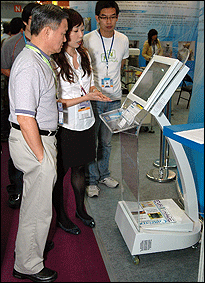The Industrial Technology Research Institute (ITRI), a group funded by the Taiwan Ministry of Economic Affairs‘ (MOEA) Department of Industrial Technology, has demonstrated an RFID system that allows visitors at conferences and exhibits to track their own movements, download product brochures and other information related to the booths they visited, and determine the locations of friends and colleagues attending the show—as well as contact them. The system also enables exhibiting companies to measure booth attendance.
The system was piloted at the Taiwan International RFID Applications Show, held in Taipei. It offers what Tony Lu, ITRI’s project leader for the pilot, calls a “virtual exhibition” scenario to help visitors see where they’ve been, and exhibit managers determine where people congregate.

“The system had been working well through the exhibition,” says Henry Jan, senior manager of ITRI’s business development division. In total, 51 exhibitors participated in the field test, and the group distributed 4,500 RFID-tagged badges to some of the 60,000 attendees who were said to have visited the show’s RFID, photovoltaic and other electronics exhibits.
One theme of the RFID Taiwan event was sustainability, Lu says, and the system helped make that possible. Many exhibitors made a point of limiting the paperwork, brochures and other paper products they distributed to visitors. Instead, the exhibitors obtained e-mail addresses from attendees, or provided their own e-mail addresses and URLs so interested parties could gain electronic access to required information. In that way, the participating companies a large percentage of paper that would have been used and discarded.
The RFID tracking system was designed to make that process easier. During registration, each participating visitor was provided a badge with an Alien Technology ALN-9540 Squiggle RFID EPC Gen 2 passive UHF tag embedded in it. The visitors then wore the badges around their necks. ITRI deployed 71 EPC Gen 2 U-Port readers that it designed and built, installing them at booths throughout the exhibit floor, and also placing seven kiosks in key locations around the same area.
The readers, wired to computers that linked the data to ITRI’s back-end system in the booths, captured the ID number on each badge as individuals browsed the booths. Each time an interrogator captured an RFID number, it stored that data in the back-end system. The ID numbers were linked to the visitors’ nationality and status, such as “VIP” or “buyer,” but not to their names. Participants could then visit one of the seven kiosks, scan their badges at the reader installed there, and select a trip report that would display a map of the exhibition and indicate which booths they had already stopped at, enabled by software developed by ITRI.
Participants with Bluetooth-enabled mobile phones could place their handsets within range of the kiosk, then download the written material related to all of the booths they’d visited. Otherwise, they could request that a booth-visit report be transmitted to their own e-mail address. However, Lu says, in other applications, users could utilize their badge ID number to log onto a Web site hosted by either ITRI or the exhibition managers, and access their own booth-visit history and product literature online.
In addition, the system offered users another function—the ability to locate friends and colleagues. If several people attended the show together, they could visit a kiosk upon arrival and scan their ID numbers, then select an option linking their numbers together as a single party. Then, if they were later separated, any party member could scan their own number, select the “locate” option and find the most recent booth that other party members had visited. The user could also send a message, such as “meet me at the entrance at 3 p.m.,” to other members of their party, who could then view the message by scanning their own ID cards at any kiosk.
The system does more than just offer services to users, however—it also enables exhibitors to track the number of people stopping at each booth, providing them with an idea of which booths are well placed and which are being overlooked. According to Lu, ITRI used generic reader modules to build the interrogators, which were able to read tags up to approximately 1 meter (3.3 feet) away but which—with additional antennas—could achieve a read range of 5 to 6 meters (16 to 20 feet).
At the beginning of the conference, ITRI set up an “RFID Register” counter to inform visitors about the test program, and to provide an information leaflet. It also positioned helpers at each kiosk to aid users. The system was unable to read badges placed in computer bags, Lu says, but successfully interrogated the badges of visitors who wore them around their necks, as intended. The response from tracked visitors, he adds, was generally positive.
“Users were particularly interested in being able to conveniently locate their companions in the exhibit hall,” Jan says, “and to download an electronic copy of a trip log without the need of bringing back a bunch of printed materials.” Exhibitors were more interested in the real-time information functions, he notes, such as comparing their own booth’s visiting rate against those of other booths at the exhibit.
The system being demonstrated could be employed at shopping malls, recreation centers and exhibits, Lu says. What’s more, ITRI hopes to see it developed for a variety of commercial applications for use in Taiwan, and possibly in other parts of the world as well.


